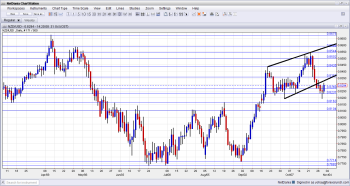The New Zealand dollar dipped to new lows but managed to remain stable in a very turbulent week. The big event for the upcoming week is the release of employment data. Here is an outlook for the events moving the kiwi, and an updated technical analysis for NZD/USD.
The RBNZ left the interest rate unchanged at 2.5% as expected and made contradicting statements: on one hand, it wants to see a lower value for NZD, but on the other hand it sees interest rates rising in 2014 – a hawkish statement. The kiwi wanted to fly higher, but it was also hurt by the relatively hawkish FOMC statement in the US. The central bank in the US did not hint about a change in QE tapering plans. Where will this pair trade next?
[do action=”autoupdate” tag=”NZDUSDUpdate”/]NZD/USD daily graph with support and resistance lines on it. Click to enlarge:
- ANZ Commodity Prices: Monday, 00:00. New Zealand relies on exports of commodities, mainly agricultural ones, for its economy. Rises in prices aid New Zealand. A rise of 0.9% was reported last month, and a more moderate rise is expected now.
- Employment data: Monday, 21:45. Contrary to most developed economies, New Zealand releases employment data only once per quarter, making this data valuable for a long period of time. The level of employment rose by 0.4% in Q2, lower than the strong gain in Q1. A stronger growth in jobs is likely now. The unemployment rate disappointed with a rise to 6.4% and no change is likely in Q3. Another data point is the Labor Cost Index, which rose by 0.4% in Q2. All in all, this is a healthy job market.
- RENZ House Price Index: Thursday, 21:00. Prices of homes have a strong impact on the New Zealand dollar, as foreign investment pours into this sector, and causes fears of a bubble. A rise of 0.8% was recorded in September. A similar number is expected in October.
* All times are GMT.
NZD/USD Technical Analysis
NZD/$ started the week trading above the 0.8270 line (mentioned last week). It then lost this line and dropped to support at 0.8230. A swing drop saw the pair temporarily falling to lower ground, but this didn’t last too long and the pair returned to the previous range.
Technical lines, from top to bottom:
The year-to-date high of 0.8676 is the top line. It stands in the distance. Below, the peak in April, at 0.8585 is the next line of resistance.
October’s high of 0.8544 is close by. At the moment, it is only weak resistance. The round number of 0.85 is also watched.
0.8435 was the peak in September – a peak that triggered a big downfall. After it was broken again, the line switched to support. It is a clear separator.
0.8360 worked in both directions at the beginning of the year: in March as resistance and in April as support. Also more recently, it worked as yet another clear separating line. Below, 0.8270 provided some support during October, and it also worked as resistance in March.
0.8230 was an important line in previous years, and also worked as support recently. 0.8160 capped the pair in August and worked as support in March. The round number of 0.81 worked as resistance in July.
Lower, 0.8050 was a peak back in June and works as support before the very round number of 0.80.
Broken uptrend channel
Since September, NZD/USD traded in an upwards channel, with uptrend resistance having a clearer role than support. As the chart shows, NZD/USD broke below this line.
I turn from bearish to bullish on NZD/USD
The RBNZ did its thing and tried to talk down the kiwi in its rate decision. Despite this and despite a relatively hawkish Fed, NZD/USD held its ground. Now that this is out of the way, the good fundamentals of the New Zealand economy are likely to push the pair higher, assuming the employment data isn’t horrible.
Further reading:
- For a broad view of all the week’s major events worldwide, read the USD outlook.
- For EUR/USD, check out the Euro to Dollar forecast.
- For the Japanese yen, read the USD/JPY forecast.
- For GBP/USD (cable), look into the British Pound forecast.
- For the Australian dollar (Aussie), check out the AUD to USD forecast.
- For USD/CAD (loonie), check out the Canadian dollar forecast.

